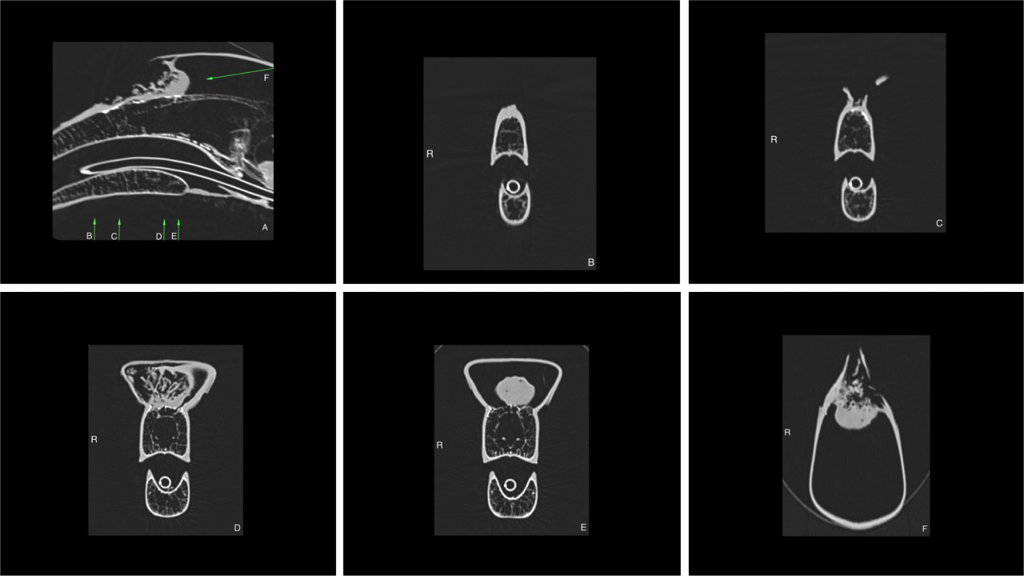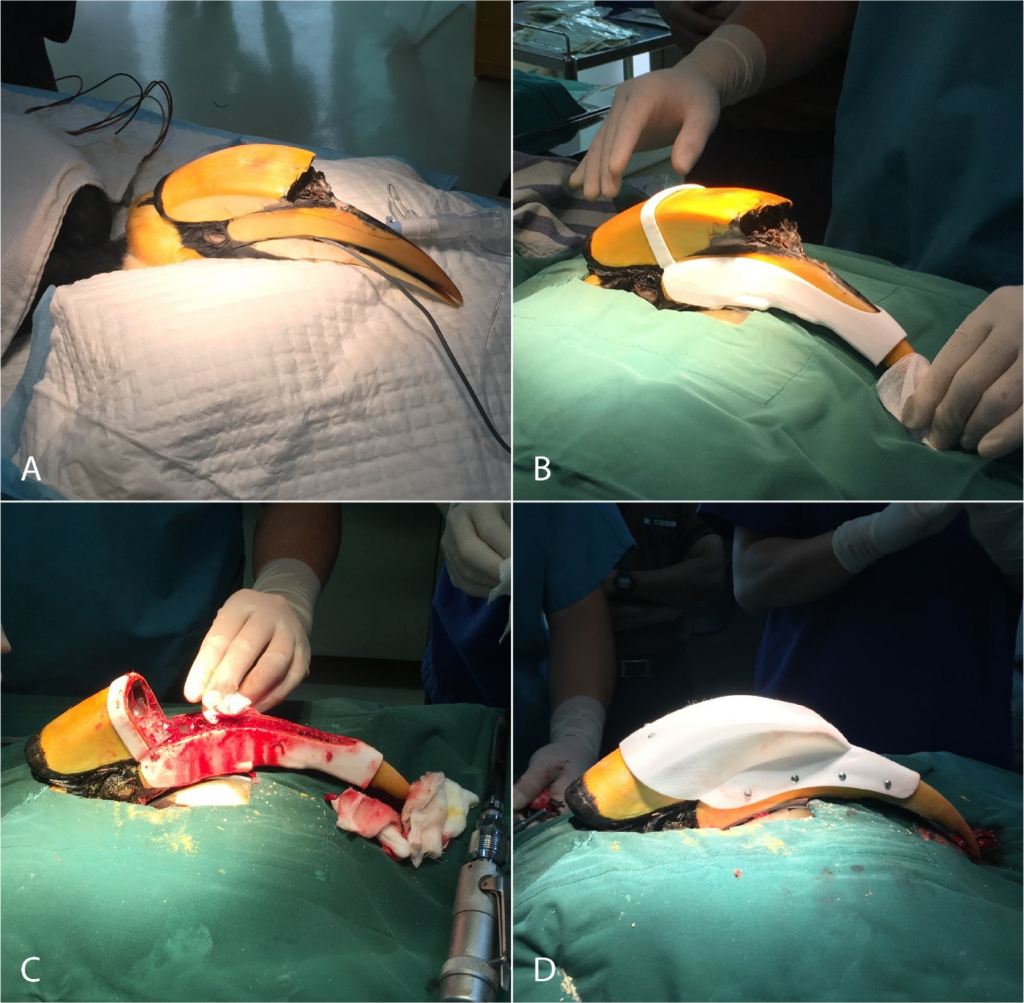While the medical field serves humans with a wide variety of new technologies and techniques, much of this is not lost on the veterinary aspect either; after all, animals also need nursing back to good health in many different scenarios. As a Great Hornbill at Jurong Bird Park was diagnosed with squamous cell carcinoma of the casque (or the bill), researchers and veterinarians in Singapore began working together to create an artificial replacement.
Outlining their findings in the recently published ‘The use of a 3D printed prosthesis in a Great Hornbill (Buceros bicornis) with squamous cell carcinoma of the casque,’ the authors explained how they offered a better quality of life to a 22-year-old male great hornbill as a portion of the bone of his beak was cancerous—a common affliction for such birds, with medical treatment usually proving to be ‘unrewarding.’
Upon deciding to excise the tissue (as there were no signs of the cancer having metastasized), the researchers went on to design and 3D print a customized surgical guide for the procedure and then a prosthesis—allowing the bird to go forth as comfortably and naturally as possible.

A: Sagittal image showing the mass, the destruction of the casque and the irregular soft tissue band extending up to the rostrodorsal aspect of the beak (the arrows indicate the plane sections of the images B, C, D, E and F); B: Transverse image at the level of the irregular band of abnormal soft tissue located dorsal to the beak (R: Right); C: Transverse image showing the destruction of the casque; D: Transverse image showing the amorphous appearance of the mass at its rostral aspect and the thickening of the nasal turbinates at the right ventral aspect of the mass; E: Transverse image showing the well-defined appearance of the mass at its caudal apsect; F: Dorsal image of the mass and casque.
Strategizing on how to treat the bird successfully, the researchers considered medications based on the squamous cell carcinoma noted in the biopsy, and then went on to consider how to deal with the size of the excision—realizing it would leave a large portion of the casque exposed. The team decided to fit the 3D printed prosthesis after excision, taking great care to create a design identical to the beak in order to avoid any effect on acoustic functionality of the casque area. Both the surgical guide and the prosthesis were created on an EOS P396 3D printer, with around 12 hours printing time required.

A: Surgical cutting guide; B: Prosthesis; C: Cutting guide on the testing model; D: Prosthesis on the testing model.
“To evaluate the fitting of the customized cutting guide and prosthesis, a replicated full dorsal maxillary beak and casque model which the area of the planned surgical margins was removed was 3D printed,” stated the researchers. “The testing demonstrated that the surgical cutting guide and the prosthesis matched the anatomy of the patient and the planned surgical margins were matched appropriately.”
As the procedure progressed, the guide was placed on the bird’s maxillary beak and casque and used to assist in removing the cancerous tissue. The 3D printed prosthetic was fixed in place with screws, and dental acrylic used as a sealant to eliminate any gaps. Surgery went smoothly, and the researchers were able to remove all cancerous tissue.
“Observation of this bird in his usual captive environment suggests that there is complete acceptance of the 3D printed prosthesis as part of its own body. This is evident from hornbill’s displaying natural coloration behavior, which coupled with the ability of the material used to take up biological pigments, enabled the prosthetic casque to appear similar in color and texture to the original rhinotheca,” concluded the researchers.
“Based on the outcome of this case, medical imaging and 3D printing can be considered a useful approach in the design and production of customized surgical cutting guides and prostheses in veterinary surgery. Collaboration between designers and veterinarians throughout the design process can result in a customized prosthesis which permits natural behaviors with good acceptance.”
As 3D printing sweeps through the medical realm offering widespread innovation and overwhelmingly positive impacts, digitally fabricated prosthetics are changing the lives of so many, and of all ages, but for many different species too—from dogs receiving 3D printed prosthetic legs to baby chicks, ducks, and even sheep. What do you think of this news? Let us know your thoughts! Join the discussion of this and other 3D printing topics at 3DPrintBoard.com.

A: Anesthetised patient before receiving the surgery; B: The patient with the 3D printed surgical cutting guide; C: The tissue affected by carcinoma was removed; D: The 3D printed prosthesis was placed and secured using cortical screws to cover the surgical wound.
[Source / Images: ‘The use of a 3D printed prosthesis in a Great Hornbill (Buceros bicornis) with squamous cell carcinoma of the casque’]
Subscribe to Our Email Newsletter
Stay up-to-date on all the latest news from the 3D printing industry and receive information and offers from third party vendors.
You May Also Like
Gorilla Sports GE’s First 3D Printed Titanium Cast
How do you help a gorilla with a broken arm? Sounds like the start of a bad joke a zookeeper might tell, but it’s an actual dilemma recently faced by...
Nylon 3D Printed Parts Made More Functional with Coatings & Colors
Parts 3D printed from polyamide (PA, Nylon) 12 using powder bed fusion (PBF) are a mainstay in the additive manufacturing (AM) industry. While post-finishing processes have improved the porosity of...
$25M to Back Sintavia’s Largest Expansion of Metal 3D Printing Capacity Since 2019
Sintavia, the digital manufacturing company specializing in mission-critical parts for strategic sectors, announced a $25 million investment to increase its production capacity, the largest expansion to its operations since 2019....
Velo3D Initiates Public Offering in a Bid to Strengthen Financial Foundations and Drive Future Growth
Velo3D (NYSE: VLD) has been among a number of publicly traded 3D printing firms that have attempted to weather the current macroeconomic climate. After posting a challenging financial report for 2023,...
































